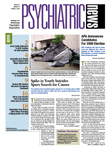Two second-generation antipsychotic agents typically prescribed to children and teens with early-onset schizophrenia were not more efficacious than an older first-generation drug, according to a report in the American Journal of Psychiatry.
The findings appear to replicate in early-onset schizophrenia what was found for adults in the landmark Clinical Antipsychotic Trials of Intervention Effectiveness (CATIE) study: that newer second-generation drugs, marketed as better as a class than the older drugs, are not necessarily superior.
In the Treatment of Early-Onset Schizophrenia Spectrum (TEOSS) study, risperidone and olanzapine did not demonstrate superior efficacy over molindone for treating patients with early-onset schizophrenia and schizoaffective disorder. Adverse effects were frequent but differed among medications, and dropout was substantial in all groups.
Weight gain was particularly prominent in the group receiving risperidone and olanzapine.
The report was posted September 15 on AJP in Advance. It will appear in the November print edition of the journal.
Lead author Lin Sikich, M.D., said that most antipsychotic prescriptions written for children and teens—as high as 98 percent—are for second-generation antipsychotics. The TEOSS study should prompt a reconsideration of that pattern, she said. Sikich is an associate professor of psychiatry at the University of North Carolina.
“Clinicians should give serious consideration to using midpotency, low weight-gain-inducing, first-generation drugs early in the treatment of kids with early-onset schizophrenia,” Sikich told Psychiatric News. “It becomes a big issue because weight gain is so much more problematic in kids than in adults.”
In the study, 116 youth aged 8 to 19 were identified at four academic medical centers and randomized to olanzapine (2.5 mg/day-20 mg/day), risperidone (0.5 mg/day-6 mg/day), or molindone (10 mg/day-140 mg/day plus 1 mg/day of benztropine) for eight weeks. The four centers were the University of North Carolina at Chapel Hill, McLean Hospital and Cambridge Health Alliance at Harvard Medical School, University of Washington, and Case Western Reserve University.
The primary outcome was response to treatment, defined as a Clinical Global Impression improvement score of 1 or 2, and at least a 20-percent reduction in the total score on the Positive and Negative Syndrome Scale after eight weeks of treatment.
No significant differences were found among treatment groups in response rates (molindone: 50 percent; olanzapine: 34 percent; risperidone: 46 percent) or magnitude of symptom reduction. Olanzapine and risperidone were associated with significantly greater weight gain. Olanzapine showed the greatest risk of weight gain and significant increases in fasting cholesterol, low-density lipoprotein, insulin, and liver transaminase levels.
Sikich said that the issue of antipsychotic-induced weight gain is especially problematic in children. They are more likely to experience weight gain associated with antipsychotic use than adults are—80 percent to 90 percent of children and teens treated with olanzapine or risperidone experience weight gain of 70 percent or more of their baseline weight—and they also gain more weight both proportionately and absolutely.
Additionally, even youth who were obese during childhood and return to a normal weight are believed to be at greater risk for cardiovascular and other health effects later in life, Sikich said.
She added that reports that children are more susceptible to extrapyramidal symptoms (EPS) have caused clinicians to shy away from using first-generation drugs. But she stressed that EPS can be controlled with anticholinergic drugs—such as benzotropine, which was used in the trial with youth receiving molindone—and propanolol.
Molindone led to more self-reports of akathisia, but was not associated with more Parkinsonian or dystonic symptoms than olanzapine or risperidone, likely because of prophylactic benztropine treatment, Sikich and colleagues wrote.
Those children who experienced akathisia were treated with propanolol.“ One question the study raises is whether clinicians should use propanolol prophylactically when treating children or teenagers with a first-generation antipsychotic,” Sikich said.
“Although it is difficult to rank the clinical importance of different adverse effects, those associated with olanzapine and risperidone are likely to have persistent effects on long-term physical health, while those associated with molindone seem more likely to impact adherence to antipsychotic medication,” the authors wrote. “However, in this trial, there was no greater attrition in the molindone group, despite more reports of akathisia.”
William Carpenter, M.D., director of the Maryland Psychiatric Research Center and a frequent critic of industry marketing of second-generation drugs, said the TEOSS study confirms that what was found by CATIE applies as well at the earliest point of treatment initiation.
“Clinicians' hope and industry marketing have made second-generation antipsychotic drugs the first choice for patients at or near their first episode of psychotic illness,” Carpenter told Psychiatric News. “Overlooked was the reasonable expectation that drugs with the same therapeutic mechanism would have the same efficacy profile. Important differences in adverse-effect profiles should guide drug selection, but recognition of efficacy similarity and adverse-effect differences has been slow in influencing practice.”
The study was supported by the National Institute of Mental Health and National Institutes of Health. Janssen and Eli Lilly and Co. provided risperidone and olanzapine, respectively, at no cost for the study.
“Double-Blind Comparison of First- and Second-Generation Antipsychotics in Early-Onset Schizophrenia and Schizoaffective Disorder: Findings From the Treatment of Early-Onset Schizophrenia Spectrum Disorders (TEOSS) Study” can be accessed at<http://ajp.psychiatryonline.org/pap.dtl>.▪
